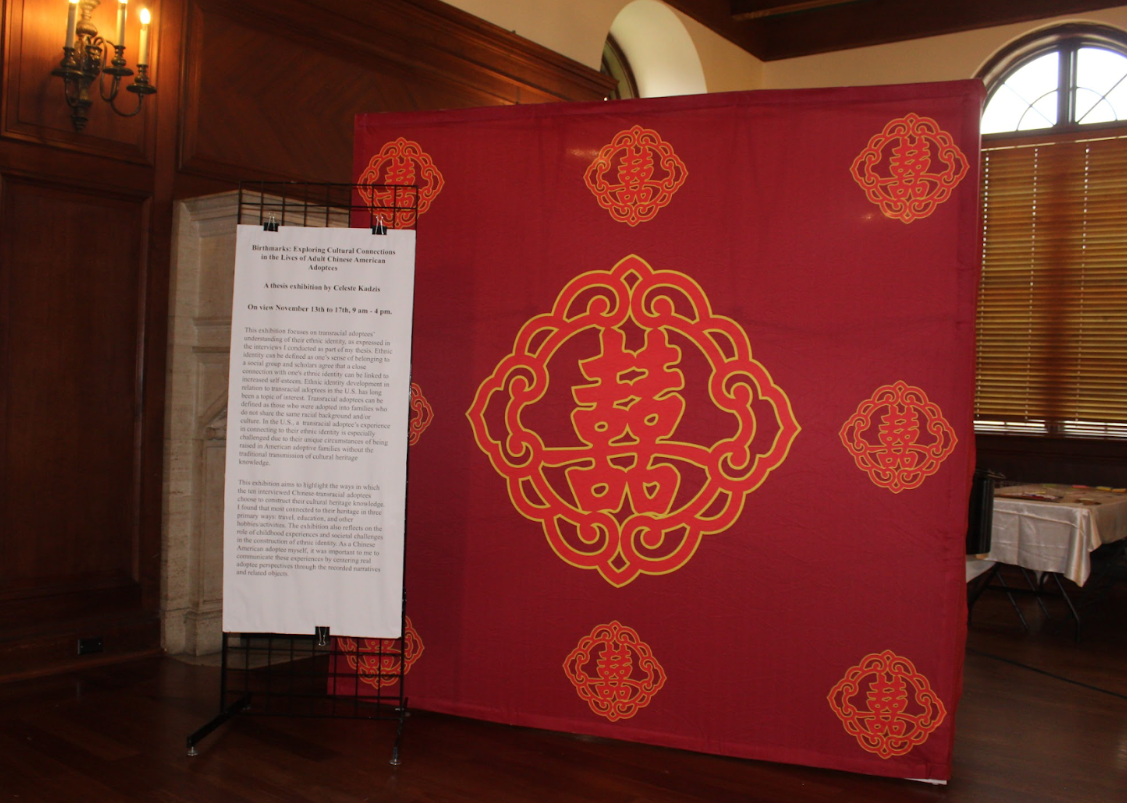On Nov. 1, the first day of Adoption Awareness Month, thesis student Celeste Kadzis announced the dates of her thesis exhibition, “Birthmarks: Exploring Cultural Connections in Chinese American Adult Adoptees.” The event took place from Nov. 13 to 17 in the College Hall Music Room and was open to all New College community members and prospective students to enjoy reading and listening to transracial adoptee experiences and stories. For those unable to attend, the Catalyst interviewed Kadzis and followed attendees through the exhibition space to gain an understanding of the work it took to assemble the project and to interpret it as a visitor.
As an Anthropology Area of Concentration student with a slash in Museum Studies under the sponsorship of Professor of Anthropology Yidong Gong and Professor of Art History and Museum Studies Katherine Brion, Kadzis came to the conclusion that an exhibition would be the perfect creative outlet to use in her thesis. Originally the plan was to direct a film, but with her subjects living across the country, the idea became unfeasible. The topic of her research was another matter. In Summer 2022, Kadzis worked as a research intern for The Park Adoption Community Center, allowing her to work with other transracial adoptees across the US and eventually forming her thesis topic as it stands today.
“Cycling back to the History of Anthropological Theory [class] last fall, we read this piece by [Clifford] Geertz where he specifically emphasizes being there,” Kadzis explained. “I was like, ‘Hm, I agree with that.’ Because I have these experiences I think that will help supplement my understanding and my ability to dive deeper into this topic compared to other people.”
The exhibition began by the stairs leading into the Music Room from the main reception area of College Hall. A kind of ambient music could be heard as the historical wood creaked under one’s feet. A large, red backdrop stood next to the introductory panel, setting the stage for the information that was to come.
“I was thinking, ‘How can I make this engaging?’” Kadzis said. “I interviewed them [adoptees] over Zoom and recorded them, and then I requested objects of value to them that kind of reflect what they talked about in our interviews.”

Following the row of introductory panels and background information leading up to Kadzis’ findings, attendees encountered the Listening Booth equipped with multiple headsets and a list of who is speaking and when. Kadzis compiled multiple clips from each interview she conducted and divided them on three recording devices that followed certain themes, such as: childhood experiences of growing up in the United States, social challenges associated with developing their ethnic identity and anecdotes about the ways adoptees choose to practice their heritage culture.
Following the Listening Booth, attendees were offered the opportunity to look at the actual objects described in the panels. These objects ranged from personal journals from time spent abroad in China to a small bunny lamp that changes colors. Each belonging held great importance to its owner, especially as a means of connecting to their heritage in many different ways.
The last piece of the interactive exhibition invited attendees to look into their own lives and heritage and write their experiences or thoughts on a Post-it note and pin it to a strip of cork board. The colorful notes detailed stories of family dinners, their own experiences as transracial adoptees and the means by which they connect to their culture.

“From the perspective of being kind of close to the curator, seeing it all come together is really motivating for my thesis,” thesis student and attendee Michael Bolesh stated. “The ambiance of the area is amazing. It definitely feels like a professional exhibit. Authenticity is something that’s always curated, but the positioning of Celeste in this, I think, makes it feel authentic beyond any superficial meaning of the word.”
Kadzis left one bit of advice for future thesis students looking to put together an ambitious interactive project. “Plan ahead, planning is best.”

